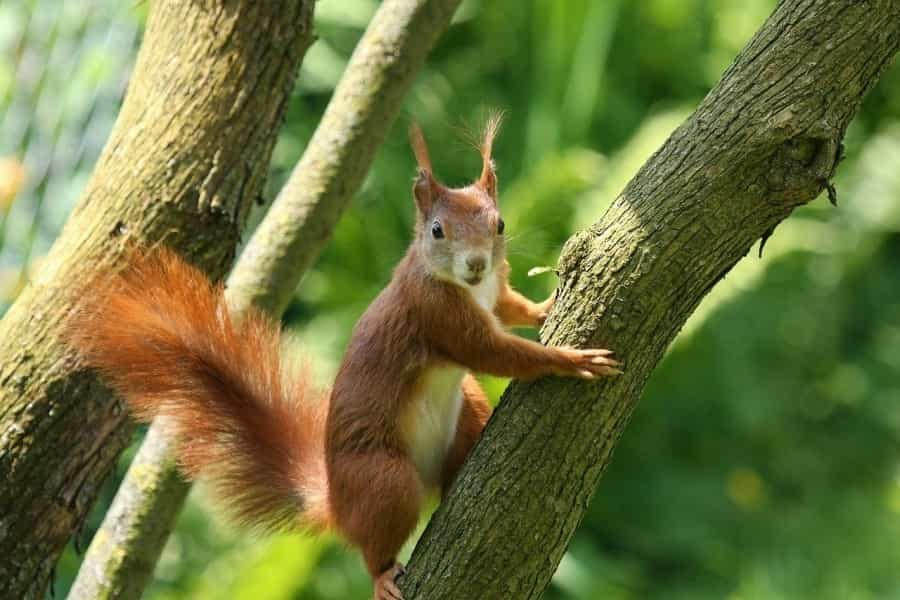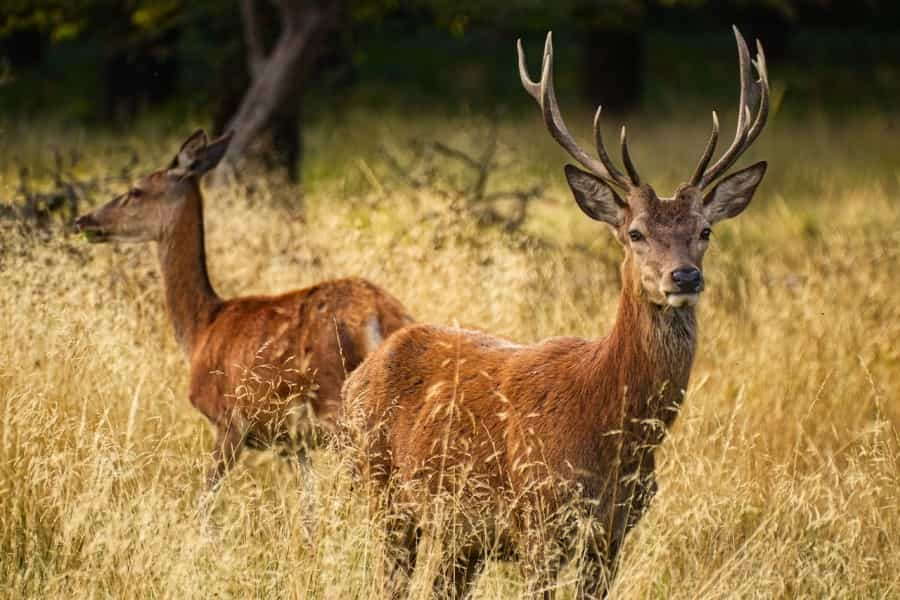Wildlife in the Lake District National Park

Blessed with a diversity of stunning landscapes and habitats, the Lake District National Park is home to an equally amazing array of wildlife, from the UK’s largest populations of endangered red squirrels to breeding ospreys and herds of native red deer. Wild ponies and hardy sheep graze the upper fells, while wading birds and amphibians thrive on the coastal dunes.
Read on for Pitchup’s guide to exploring the wildlife of the Lake District National Park, including suggested spots for reliable sightings and a couple of suggestions for family trips to view some rather more exotic wildlife.
Lake District habitats
The spectacular but fragile landscapes of the Lake District National Park – from untamed upland to coastal dune – have been sculpted and shaped by glaciation, water erosion and the actions of man over many centuries.
The high fells
Swathed in alpine heath, grass and brackens, the fells are largely bare of trees. Wild Fell ponies can sometimes be seen grazing on the open hillsides, while hardy Herdwick sheep – with their trademark white faces and silvery-grey fleeces – are a very common sight.

River, lakes and tarns
The freshwater lakes that cover much of the Lake District National Park are pure in quality, rich in nutrients and attractive to plant species such as white water lilies, plantains, rushes and pillwort. They also support extensive areas of reed bed and swamp fringed by willows and alder, which bring in dragonflies, beetles and waterfowl, while the rivers are rich in fish including Arctic charr, trout and perch.
Valleys
The lower valleys of the Lake District have been shaped by centuries of farming; hay meadows and grazing pastures carpet Troutbeck Valley, lower Ennerdale and Ullswater. As well as the iconic Herdwick sheep, you’re likely to see Belted Galloway cows with their distinctive white girdles out in the fields; this tough breed can withstand low temperatures and stay out all winter.
Broadleaf woodlands
Extensive and ancient upland woodlands survive in several valleys like Borrowdale, and stretch up to the treeline throughout the park. The Lake District is the home of the UK’s biggest population of red squirrels, and although they are somewhat elusive, you’re most likely to catch them among the trees, particularly in spring before the leaf canopy grows over.
Top tip: Look out for the triangular road signs asking you to ‘please slow down’ in areas where red squirrels can sometimes be found.

The coastline
The Irish Sea coastline is low lying, with a mixed ecosystem of mudflats, salt marsh and sand dunes backing wide beaches. The habitat shelters grey seals, migratory birds like teal and snipe, and amphibians including frogs, newts and rare natterjack toads.
When and where to see wildlife in the Lake District
Although you can see plenty of wildlife whenever you visit the national park, here are five places to visit where sightings of specific species are reliable at certain times of the year.
Derwentwater
The walking and boating hotspot of Derwentwater is also rich in birdlife, with sightings of 168 species recorded. Watch out for barnacle geese, goosanders, moorhens and black-headed gulls on the water, and otters swimming close to the lake shoreline. Standing high above the lake, the Borrowdale oak woods hide the nests of peregrine falcons as well as barn, tawny and little owls, and also has a colony of red squirrels. You should listen out for red deer stags roaring during the November rut.
Good to know: While red squirrels can be observed all year round, they are more easily spotted in spring, before the leaf canopy develops, and in autumn when it has died back.

Dodd Wood
Managed by Forestry England, Dodd Wood, in the North Lakes, is a broadleaf woodland riddled with scenic walking trails; try the Dodd Summit walk for spectacular views over Bassenthwaite Lake and the chance to see red squirrels throughout the year. In summer, you might get lucky and see the famous Bassenthwaite ospreys – fish-feeding raptors with a five-foot wingspan and white heads – diving into the lake for food.

Foulshaw Moss Nature Reserve
Foulshaw is a precious area of peat bog and water known as a ‘lowland raised mire’ in Lakeland parlance. Unusual dragonflies and damselflies dance over the pools, which are feeding ground for wetland birds (including rare water rail) and raptors, but the stars of the show here are the nesting ospreys, which return to the reserve between March and September.
Good to know: If you can’t visit Foulshaw Moss in person, you can observe the ospreys on the dedicated webcam.
Grizedale Forest
Bursting with wildlife from badgers to foxes, and butterflies to barn owls and red kites, Grizedale also supports England’s last remaining wild woodland herd of red deer. For a good chance of spotting the deer at any time of year, follow one of the number of forest paths or mountain-bike trails starting from the visitor centre, which has occasional exhibitions on local flora and fauna.
Whinlatter Forest Park
A haven for family outings, mountain biking and serious fell walking, Whinlatter is home to foxes, roe deer, amphibians and birds of prey including peregrine falcons and buzzards. Best of all, here you have another chance to see the Bassenthwaite ospreys in spring and summer, and red squirrels all year round.
Conservation efforts in the Lake District
The park authorities have a long-term plan in place to protect fragile Lake District habitats; check out the national park website for details, and read on for two other projects that are ongoing in the region.
Ennerdale
One of Cumbria’s lesser-known lakes and valleys, Ennerdale is the subject of a massive rewilding project that has seen local landowners work with Forestry England and the National Trust to protect its wild scenery. Support Wild Ennerdale by visiting to (hopefully) spot the red and roe deer herds, and colourful butterflies like orange-tips and marsh fritillaries, which have been reintroduced to the area. Belted Galloway cows also graze the area freely, so keep dogs on leads. Access is free for National Trust members.
Haweswater Nature Reserve
The reserve’s ancient woodlands, rugged heath and moorland is managed by the Royal Society for Protection of Birds in conjunction with the landowner; the landscape has been transformed by sustainable farming, the planting of trees and the rewetting of peat bogs. Help finance the conservation project by donating, leaving a legacy in your will or volunteering your time.
The Lake District Wildlife Park
Set against the awe-inspiring backdrop of Skiddaw and sitting on 24 acres at the northern tip of Bassenthwaite, the park is one of the Lakes’ most popular visitor attractions. It’s home to – among many others – a myriad of birds, monkeys, lemurs, wildcats, rare-breed sheep and zebras, and makes a fun-filled, educational and inspirational day out for all the family. You can take alpacas for a stroll or meet the tapirs, watch raptor displays or listen to keeper talks, and there’s a soft play centre for younger guests as well as picnic spots and a café.
Found 15 minutes’ drive north of Keswick, the park is open daily from 10am to 5pm; admission prices are currently around £50 for a family ticket. When you’re looking for accommodation, Pitchup has a range of family-friendly Lake District campsites.
Good to know: If you haven’t quite had your fill of exotic wildlife, you can also visit the Lakeland Wildlife Oasis, 10 minutes’ drive south of the park, to encounter a range of creepy crawlies and endangered snow leopards.
Wildlife photography in the Lake District
If you’re something of a nature photographer, Cumbria and the Lakes are sure to keep you busy. Head for the bird hides on the Solway Firth and Haweswater for virtually guaranteed sightings of sea and wetland birds, or Foulshaw Moss to film the osprey pair nesting over summer.
If you’d like to learn from a professional, local photographers Melvin Nicholson and Paul Fowlie run a number of courses and workshops throughout the year.
Good to know: There is a free app that can turn even the most amateur of wildlife spotters into pros. Download iNaturalist to record your sightings within the national park.
Planning a Lake District holiday? Pitchup has a wide range of accommodation across the national park, from camping and glamping to caravan parks with lots of facilities.
Looking for more information about the Lakes? Have a look at our other guides to the region, covering everything from mountain hikes to family days out with the kids.